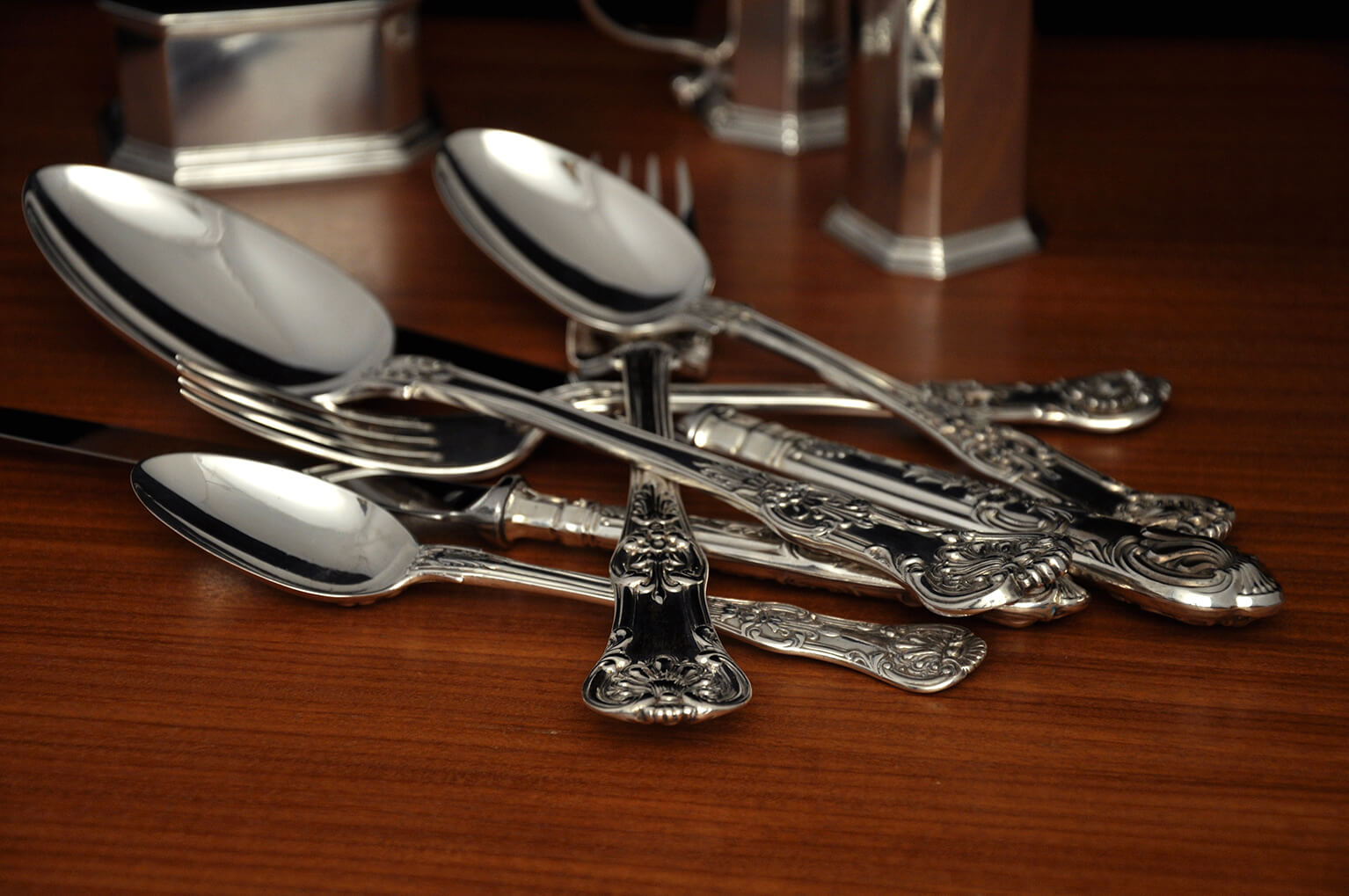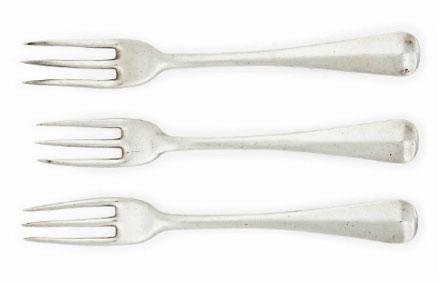ANTIQUE SILVER FLATWARE - BUYING GUIDE
Handmade by master craftsmen, the quality of Antique Silver Flatware far outstrips anything being made today. The process of hand forging makes it stronger and better weighted than modern stamped out flatware whilst the sophistication of design is superb. However, when buying antique silver cutlery, there are few extra things to consider. This guide explains everything you need to know.

INTRODUCTION
In order to make sure you get the best possible set for you, we recommend reading the guide below. It contains three sections. The first explains the different types of flatware available. The second explains why most sets come with new knives and the last contains some important pointers to make sure you get a good quality set. If you have any questions, don’t hesitate to contact us by phone or email and one of the Franks family will be happy to help and advise you.
1. TYPES OF ANTIQUE SILVER FLATWARE SETS
The hallmarks on a set of flatware and how these hallmarks vary from piece to piece has a significant effect on the pricing of that set. There are three different categories, explained below.
Single Maker /
Single Year Sets
In a Single Maker / Single Year Set, every piece has exactly the same hallmarks. That means it was all made by the same maker in the same year. Obviously, for an antique set to have remained together its entire life without losing any pieces is quite rare and for this reason, Single Maker / Single Year Sets are the most expensive type of sets. You will have to pay a considerable premium for a Single Maker / Single Year Set over the price of a Single Maker / Mixed Years Set and if you lose a single piece, you will lose that premium.
Single Maker /
Mixed Year Sets
In this type of set, all the pieces are made by the same Maker but over a range of years. This is a great way to buy cutlery because you have the consistency of a set made by a single maker but without paying the premium of a Single Maker / Single Year Set. The size of the date range affects the price of the set. A short date range of only 5 years will be more expensive than a longer date range of 20 years. Single Maker / Mixed Year Sets are usually assembled by us and we take great care to make sure that the pieces match well.
Harlequin Sets
(Mixed Makers & Years)
The pieces in a Harlequin set are all the same pattern but made up of various makers and years. These sets are usually assembled by us and we take great care to make sure that when the table is laid the place settings look consistent. Harlequin sets are the most affordable type of set but are still wonderful quality and look beautiful on the table.
2. WHY DO MOST THE SETS HAVE NEW KNIVES?
As you browse our website, you’ll notice that the vast majority of sets don’t include knives. Instead, new matching knives are offered as an optional extra. The reason for this is that old knives were mild steel and they rusted. Mild steel is also quite soft and it wore down. As such, most old knives were considered disposable and would have been used until they wore out and then simply replaced. In fact, if you look at an antique Canteen of Cutlery, you will usually see that there is no space for the knives, which would have been bought separately and stored in their own box.

Because the old knives were disposable, the vast majority were made with bone handles. However, a small number of very wealthy people did have silver handled knives despite the fact that the blades wore out. Sometimes, it is possible to find a set where the the old silver knife handles have been re-bladed with stainless steel blades. These sets are rare but we usually have a few examples in stock. Whenever a set is sold with the old knives, this is clearly shown on our website.
The introduction of stainless steel knife blades didn’t happen until the 1920s and 30s. From that period on, it is easier to find sets with the original knives. However, the majority of these sets were sold with resin handled knives. Silver handled knives continued to be rare until the 1960s.
From the 1960s to the present day, the way silver handled knives are made has developed considerably and today’s silver knives are dishwasher proof and extremely hard wearing. The days of pitch (black goo) emerging from between the handle and blade are long gone.
Taking into account the improved durability of new knives and the rarity of re-bladed old knives, most people opt for new sterling silver and stainless steel knives designed to match their old set.
3. HOW TO RECOGNISE A GOOD QUALITY SET
When buying old flatware, its important to make sure that the condition is good. At I.Franks we don’t sell any flatware that we don’t consider to be in excellent condition. When we appraise cutlery we look at two main things...

First of all we check the lengths of the prongs on the forks and the ends of the bowls on the spoons. These are the two areas which get the most wear. After a hundred years, over used sets end up with uneven prongs on the forks and misshapen bowls on the spoons. Sometimes, a silversmith will cut down and reshape either the fork prongs or the spoon bowls. In this case the shape will improve but the fork prongs will become short and the spoon bowls will end up thin. We always make sure that the prongs are good and long and the spoons have a nice, properly formed bowl. Otherwise, we just don’t buy them.
The second important thing we check for is to make sure that the decoration is in good condition. If the set has been over polished, the decoration appears rubbed and soft. In extreme cases, there may even be areas where the decoration becomes indistinct. At I.Franks we only buy flatware where the decoration is in good condition.
When comparing sets of antique flatware, its important to take the condition into account. A worn out set will be considerably cheaper than a good condition one. So, if you see cheaper flatware elsewhere, make sure to check the condition carefully.